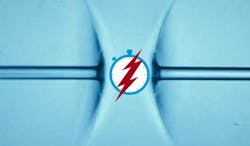Celebrate femtosecond week with SLAC April 17-21
Got a millionth of a billionth of a second? There's science that actually happens on this timescale--an ultrafast reality that is being celebrated by the SLAC National Accelerator Laboratory (Menlo Park, CA).
RELATED ARTICLE: Upgraded 200 TW laser at SLAC synchronizes with x-ray laser for research
Join SLAC online for a week of ultrafast science from April 17 to 21 and learn more about how scientists and engineers use electron beams and bright pulses of light from the Linac Coherent Light Source X-ray laser and other advanced lasers to capture some of nature’s speediest processes that occur in just femtoseconds, or quadrillionths of a second. The schedule includes:
Monday
- Physicist Phil Bucksbaum, director of the PULSE Institute at Stanford University and SLAC, gives a brief introduction to why we study on a femtosecond timescale.
- In a video interview, Ryan Coffee, scientist at the Linac Coherent Light Source, explains, “What is a femtosecond?”
- Accelerator physicist Agostino Marinelli discusses how we make femtosecond light.
Tuesday
- Learn how we capture femtosecond light with detectors from Gabriella Carini, scientist at the Linac Coherent Light Source.
- Explore the fourth dimension, from processes that occur in billions of years down to tiny slivers of a second.
- Find answers to your burning questions about ultrafast X-ray science. Mike Dunne, director of the Linac Coherent Light Source—the world’s first hard X-ray free-electron laser—will join us for a Twitter chat.
Wednesday
- What can you study in femtoseconds? PULSE scientist Amy Cordones-Hahn describes her work on chemical reactions that turn sunlight into useable energy.
- Take a virtual tour of the undulators and near experimental hall at the Linac Coherent Light Source.
Thursday
- Read about how SLAC professor Siegfried Glenzer creates extreme conditions like those in the cores of planets and studies nuclear fusion.
- Our ultrafast science factsheet gives an overview of the femtosecond world.
Friday
- What else can you study in femtoseconds? Aaron Lindenberg, associate professor at Stanford and SLAC, talks about how he combines X-ray and electron techniques to understand and engineer novel materials.
- And, what’s faster than a femtosecond? Researchers at SLAC are already looking at the largely unexplored realm of attosecond science.
SOURCE: SLAC; https://www6.slac.stanford.edu/news/2017-04-12-slac-celebrates-femtosecond-week.aspx

Gail Overton | Senior Editor (2004-2020)
Gail has more than 30 years of engineering, marketing, product management, and editorial experience in the photonics and optical communications industry. Before joining the staff at Laser Focus World in 2004, she held many product management and product marketing roles in the fiber-optics industry, most notably at Hughes (El Segundo, CA), GTE Labs (Waltham, MA), Corning (Corning, NY), Photon Kinetics (Beaverton, OR), and Newport Corporation (Irvine, CA). During her marketing career, Gail published articles in WDM Solutions and Sensors magazine and traveled internationally to conduct product and sales training. Gail received her BS degree in physics, with an emphasis in optics, from San Diego State University in San Diego, CA in May 1986.
